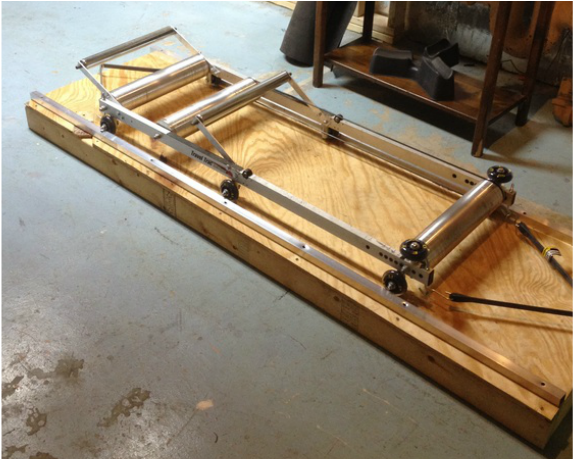As cyclists, I know there are a lot of do-it-yourself types out there. Why spend your hard earned money on something on something you could build yourself, for less? If that sounds like something you would say and you’ve been looking for a better way to train indoors this Winter, here you go. If you know what rollers are, you are probably familiar with the Inside Ride E-Motion rollers which are fantastic. Basically, the roller frame floats back and forth on a separate frame which combined with additional support rollers for the rear wheel and front wheel bumpers makes roller use easier and more enjoyable. While the Inside Ride version will ultimately be more portable, not everyone has $900 to drop on something they only hope to use on the worst days of the Winter months.
Ever since suspended rollers became a thing, there have been DIY versions but few have the detail of the plans sent into us by Adam St. Germain. Compiled on the Short Handled Shovel blog penned by ASJ and Noah Jacobs, the DIY instructable takes roughly $125 of raw materials plus a set of rollers and transforms them into an impressively functional set of suspended rollers…
Materials needed:
- 1 set of rollers- you should already own these.
- 8 rollerblade wheels w/bearings ($19.99) 70mm or bigger!
- 2 21″ bungee cords ($1.99 ea)
- 2 8′ 2x4s
- 1 sheet of plywood big enough to fit under your rollers
- 2 Paper making Conveyor rollers ($17.08 ea)
- 2 sections of 1″x1″x84″ aluminum square tubing ($16.01 ea)
- 1 piece of 1″x1/8″x48″ aluminum flat bar mill ($17.65)
- 8 1.5″ bolts and nylock nuts.
- 6 2.5″ 5/8″ bolts and nylock nuts
- 2 4.25″ 58″ bolts and nylock nuts
- 2 machine threaded hooks w/nuts
- 2 wood thread 5 hooks, heavy duty.
- 1 box of 100 count 5/8″ ID washers
- 2 1/4″ deck screws or similar
- Drill (or drill press preferably)
- Circular saw or similar.
- Hammer
- Hacksaw
- Measuring tape
- Pencil
- 1/16″, 1/4″, 5/8″, 1/2″ drill bits
- Safety glasses if you so choose and cherish your eye sight.
- A broom and shop vac sure are handy as well.
- Bonus materials- 2 fixed casters, 1 drawer handle, paint.
For the complete how-to, head over to Short Handled Shovel.
Thanks to ASJ for sending that in!
